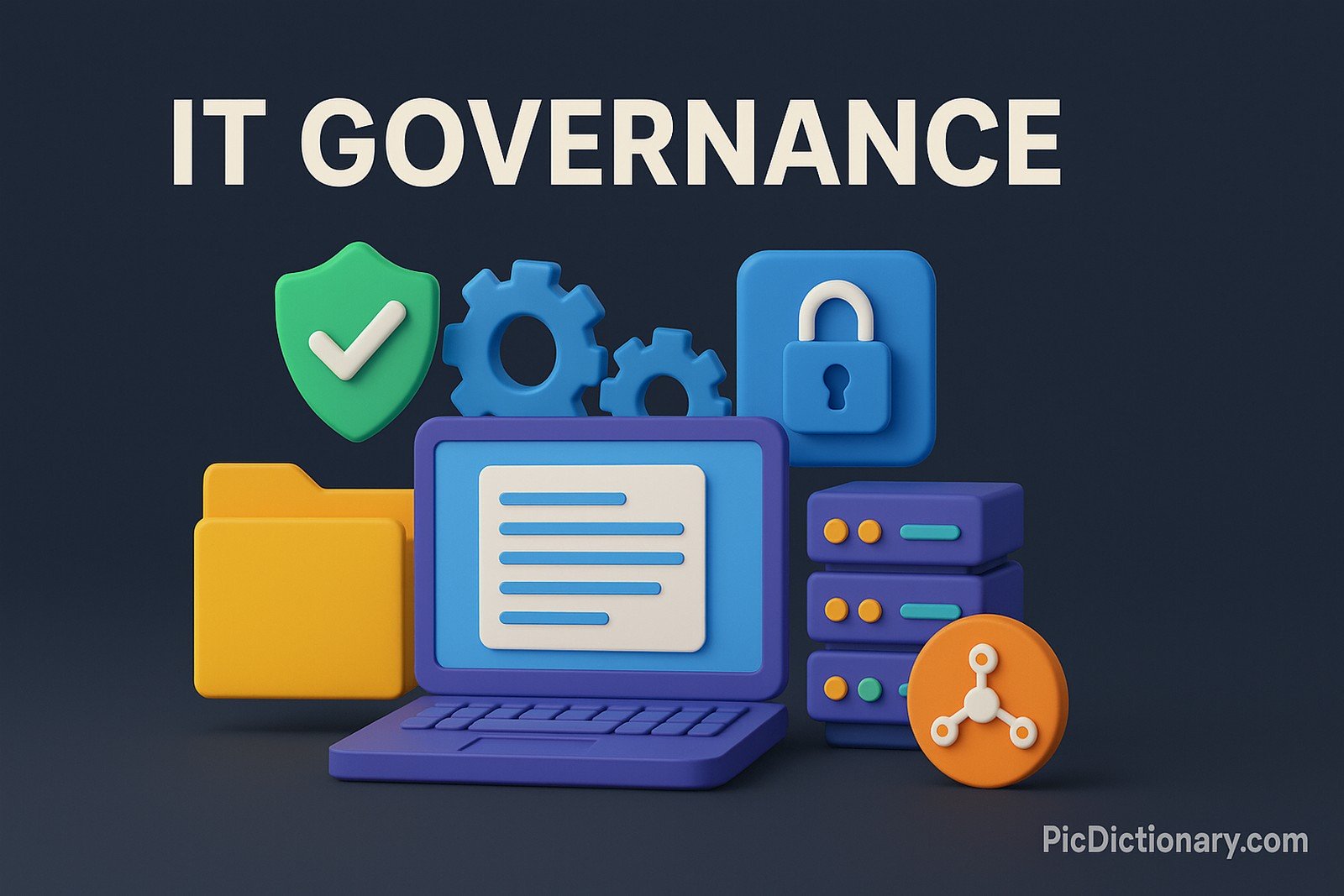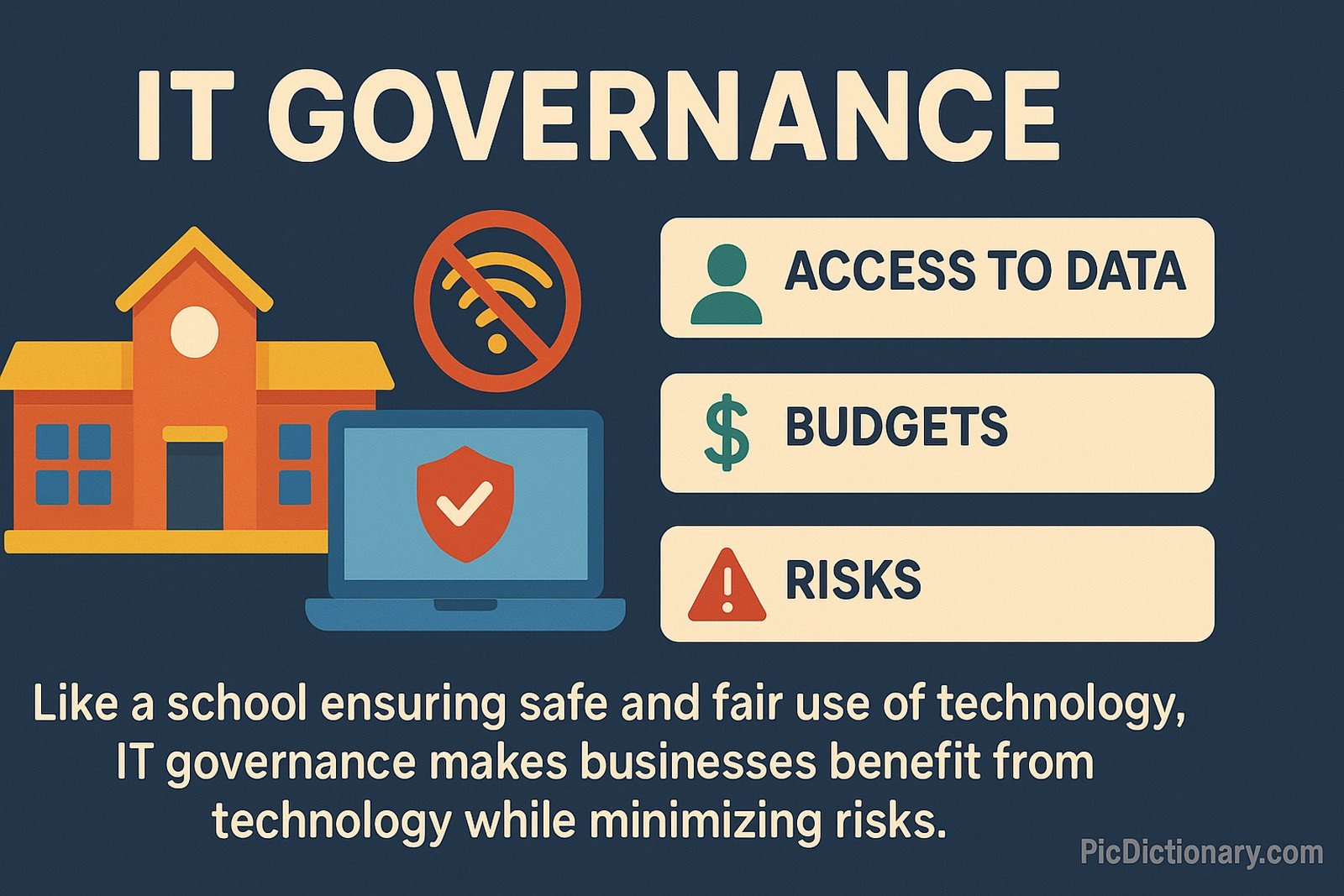IT Governance

Quick Navigation:
- IT Governance Definition
- IT Governance Explained Easy
- IT Governance Origin
- IT Governance Etymology
- IT Governance Usage Trends
- IT Governance Usage
- IT Governance Examples in Context
- IT Governance FAQ
- IT Governance Related Words
IT Governance Definition
IT governance refers to the framework and processes that ensure the effective and efficient use of IT in enabling an organization to achieve its goals. It encompasses decision-making structures, policies, and accountability mechanisms that align IT strategy with business objectives. Key components include risk management, compliance, resource optimization, and performance measurement. IT governance frameworks, such as COBIT, ITIL, and ISO/IEC 38500, provide structured approaches to managing IT resources responsibly.
IT Governance Explained Easy
Think of IT governance like the rules and guidelines a school has for using its computers and the internet. Just like a school ensures that students use technology safely and fairly, IT governance ensures that businesses use technology in a way that benefits them while minimizing risks. It helps organizations decide who can access data, how technology budgets are spent, and how IT-related risks are managed.
IT Governance Origin
IT governance emerged in the late 20th century as businesses became more dependent on technology. With the rise of computing in the 1980s and 1990s, organizations needed structured approaches to managing IT investments and risks. Various governance frameworks evolved to address growing concerns about cybersecurity, compliance, and technology-driven decision-making.
IT Governance Etymology
The term “IT governance” derives from the broader concept of "governance," which refers to the process of managing and overseeing operations. "Governance" originates from the Latin word gubernare, meaning "to steer" or "to direct."
IT Governance Usage Trends
IT governance has gained significant attention with the rise of cybersecurity threats, data privacy regulations, and digital transformation. Organizations worldwide implement IT governance frameworks to comply with legal requirements like GDPR, HIPAA, and Sarbanes-Oxley. Cloud computing, AI, and remote work trends have further emphasized the need for strong IT governance practices.
IT Governance Usage
- Formal/Technical Tagging:
- IT Management
- Risk Management
- Compliance - Typical Collocations:
- "IT governance framework"
- "data protection policies"
- "risk assessment in IT governance"
- "IT compliance and security measures"
IT Governance Examples in Context
- A multinational company implements an IT governance framework to ensure compliance with data privacy laws.
- A healthcare provider uses IT governance to manage patient data securely.
- An e-commerce business applies IT governance principles to prevent cyber threats and fraud.
IT Governance FAQ
- What is IT governance?
IT governance is a framework that ensures IT resources are used effectively and align with business goals. - Why is IT governance important?
It helps manage IT risks, ensures compliance with regulations, and optimizes technology investments. - What are the main IT governance frameworks?
Common frameworks include COBIT, ITIL, ISO/IEC 38500, and NIST Cybersecurity Framework. - How does IT governance differ from IT management?
IT governance focuses on policies and oversight, while IT management deals with daily IT operations. - Who is responsible for IT governance?
Executives, IT leaders, and governance committees oversee IT governance in an organization. - How does IT governance improve cybersecurity?
By implementing policies and controls to protect IT assets and data from cyber threats. - What industries benefit from IT governance?
Healthcare, finance, e-commerce, government, and manufacturing all rely on IT governance. - How does IT governance support digital transformation?
It ensures IT initiatives align with business objectives while managing associated risks. - What role does compliance play in IT governance?
IT governance helps organizations meet legal and regulatory requirements related to technology. - Can small businesses benefit from IT governance?
Yes, even small businesses can implement basic governance principles to enhance security and efficiency.

IT Governance Related Words
- Categories/Topics:
- Corporate Governance
- Cybersecurity Compliance
- IT Risk Management
Did you know?
One of the earliest formal IT governance frameworks, COBIT, was developed in 1996 by ISACA. It remains a widely used standard for managing IT-related risks and aligning IT strategies with business goals.
PicDictionary.com is an online dictionary in pictures. If you have questions or suggestions, please reach out to us on WhatsApp or Twitter.Authors | Arjun Vishnu | @ArjunAndVishnu

I am Vishnu. I like AI, Linux, Single Board Computers, and Cloud Computing. I create the web & video content, and I also write for popular websites.
My younger brother, Arjun handles image & video editing. Together, we run a YouTube Channel that's focused on reviewing gadgets and explaining technology.



Comments powered by CComment